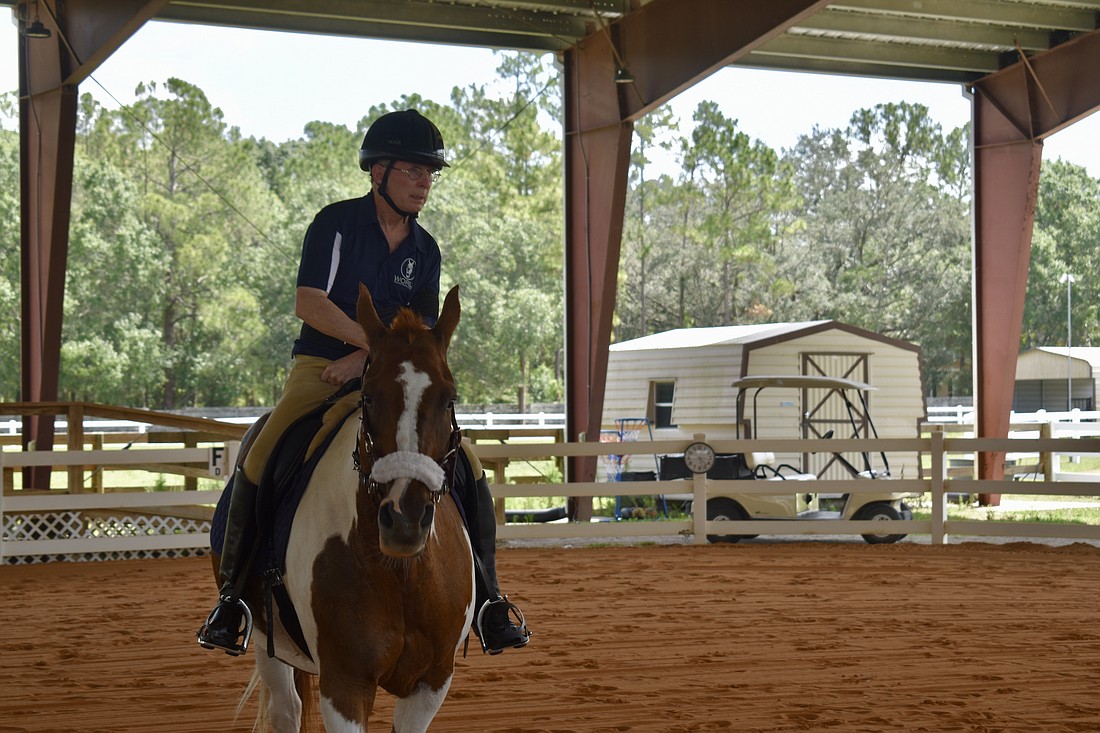- May 12, 2025
-
-
Loading

Loading

When Dan Mohl’s equine therapy session nears its finish, instructor Ilee Finocchiaro places a speaker in the center of the riding ring.
In the background, Bryan Adams goes into the chorus of “Summer of ‘69," as Mohl guides his horse Frieda from a walk to a trot.
Mohl, 63, was a dressage rider before a back injury in 2017 and a hemorrhagic stroke in 2010. His therapy has led him to the Sarasota Manatee Association for Riding Therapy.
SMART has been offering therapeutic horseback riding and equine-assisted learning programs since 1987. In 2011, the nonprofit purchased a 23-acre equestrian center off County Road 675, where it is home to 14 horses.
Due to the stroke, Mohl's left arm has to be put into a brace, so it won’t hit the saddle as he rides. He’s lifted on top of the saddle with the help of a device called "SureHands" that hooks underneath his thighs and raises him up and over the horse.
“The way the horse walks is the way people walk,” Mohl said. “I had to learn to walk all over again after my stroke, so the horse really helped.”
Finocchiaro has been with SMART for nearly nine years and is the lead instructor. She says horseback riding helps Mohl with his balance, core strength and muscle tone.
Finocchiaro gently straightens and bends Mohl’s left leg before he rides. He can stretch his right leg on his own. He maintains a daily exercise routine with a physical therapist at The Fountain of Hope in Sarasota, the assisted living facility where he lives.

To Mohl, there’s no better workout for his body or brain. During his 30-minute session, there’s nothing else to think about but Frieda’s next move. No matter the physical limitations of those taking the classes, equine therapy can help patients deal with anxiety, depression and post-traumatic stress disorder, too.
“We do a huge veterans program out here with a group called Operation Warrior Resolution," Finocchiaro said. "We do retreats and six-week programs with them. When you think of disability, it doesn’t have to be something you physically see with your eyes.”
SMART serves cancer patients, victims of sex trafficking and people with attention deficit disorder—any type of physical, emotional or cognitive disability.
Riders are introduced to the horses before they get into the saddle. Those who might have a fear of riding get comfortable by grooming the horse, building a connection. SMART also offers an Equicizer, a wooden horse that moves like a real one.

The nonprofit serves more than 450 participants and their families each year. The cost is $60 an hour for group lessons and $75 per half hour for private lessons. Riders must be at least 4 years old.
Program fees only account for 11% of SMART’s total revenues. It maintain a scholarship fund that supports riders who wouldn’t be able to afford the therapy otherwise. Individuals and local organizations like the Lakewood Ranch Community Fund and Manasota BUDS contribute.
“It’s so hard to get grants that allow us to put the money toward the participants. That’s why we rely so heavily on donations,” Finocchiaro said.
SMART’s annual budget is about $400,000, of which about $40,000 goes to bales of hay alone. One bale costs $24, and the horses eat 35 of them every week.
But SMART volunteers said a price can't be put on something like a mother hearing her child audibly communicate for the first time. A volunteer with SMART for 15 years, John Moore shared a story he never will forget.
“Years ago, I was leading the horse," Moore said. "We had a young boy, probably 9 years old, who was nonverbal. And for the horse to go, you have to say ‘Walk on.' Obviously, this kid didn’t say anything. Then, after a couple weeks, we got an ‘Aaaah.’”
With that, Moore shouted, “Close enough, off we go!”
He said about a month later, the “Aaaah” turned into “Aaaah on.”
“The mother was almost in tears,” Moore said. “That’s one of the neat things that happen out here.”